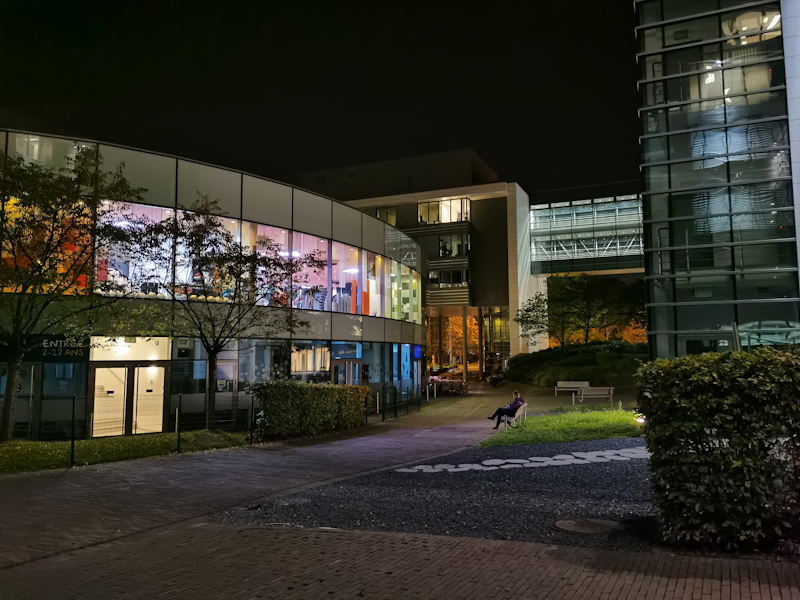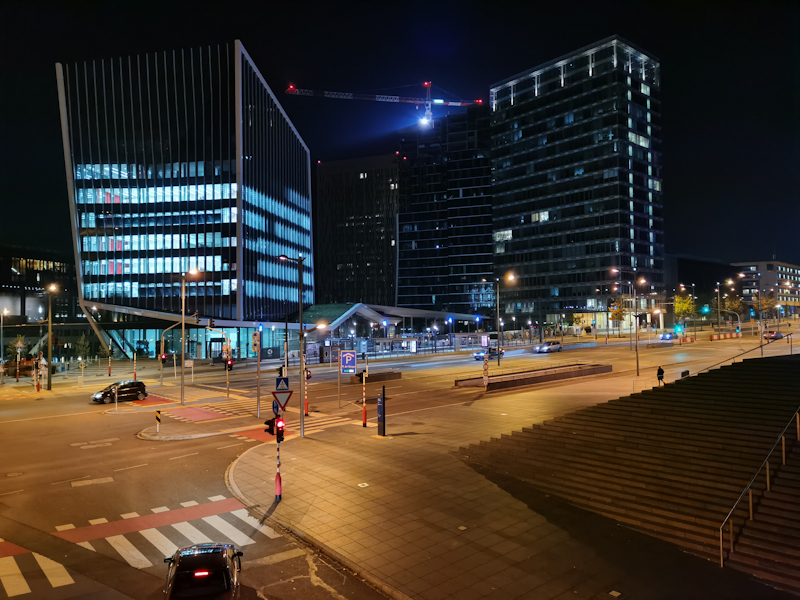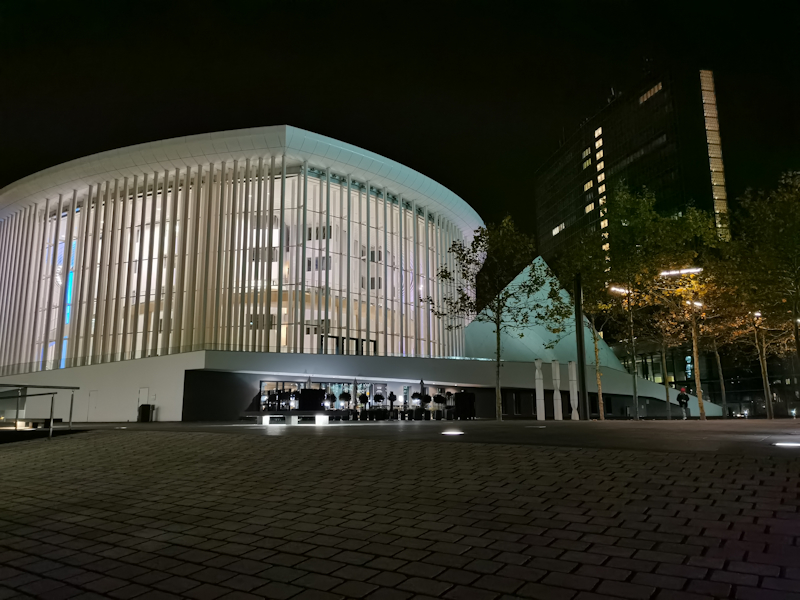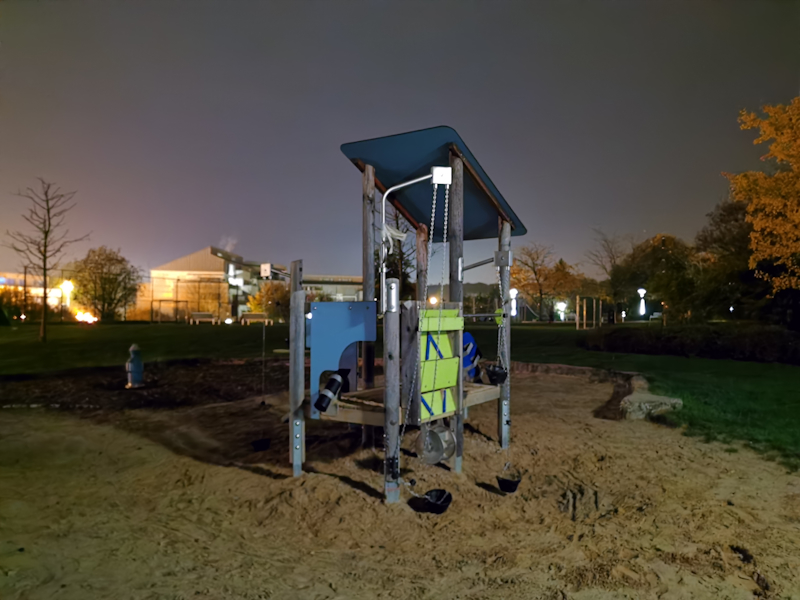The Huawei Mate 30 Pro Review: Top Hardware without Google?
by Andrei Frumusanu on November 27, 2019 10:00 AM EST- Posted in
- Mobile
- Smartphones
- Huawei
- Kirin 990
- Mate 30 Pro
Camera - Low Light Evaluation
Low-light performance of the Mate 30 Pro should be pretty straightforward. Huawei has been in the leading position for over 2 years now thanks to its raw hardware capabilities and big custom sensors. I expect the Mate 30 pro to continue to hold on to the lead, but let’s see if there’s been any changes in the processing with the new SoC.

[ Mate 30 Pro ] - [ P30 Pro ]
[ S10+ (S) ] - [ S10+ (E) ]
[ iPhone 11 Pro ] - [ Pixel 4 ]
[ G8X ] - [ Xperia 1 ]
In the regular shooting mode, we’re seeing that the characteristic of the new phone not applying a degrading sharpening filter also applies to low light photography, and the Mate 30 Pro is able to achieve much better detail than the P30.
We also see that the tone mapping has improved slightly, there’s a bit more depth in the lightning on the building and walkway which was flattened out on the P30.
Switching on Night mode which makes use of image stacking, we lose details in the shot, but do make it brighter with better dynamic range. The night shot differences to the P30 here are extremely minor.
Using the new UWA in low-light, we’re presented with a whole new view of the world. Where previous generation UWA modules completely failed at low-light, the Mate 30 Pro is able to breeze through the scenario without much of a sweat and produces an outstanding result. There’s no other phone that can keep up with it.

[ Mate 30 Pro ] - [ P30 Pro ]
[ S10+ (S) ] - [ S10+ (E) ]
[ iPhone 11 Pro ] - [ Pixel 4 ]
[ G8X ]
On the next scene there’s a very big change in colour temperature, and unfortunately the Mate 30 Pro got it wrong this time around as the more orange look of the P30 was the actual representation of the scene with the sodium lamps. While the colours are wrong, again the detail retention of the Mate 30 Pro is outstanding, although the Pixel 4’s Night Sight as well as the iPhone 11 with deep fusion are competitive with it.
The ultra-wide-angle is accurate in its colour temperature, and again it’s leagues ahead of the competition in all aspects of picture quality.

[ Mate 30 Pro ] - [ P30 Pro ]
[ S10+ (S) ] - [ S10+ (E) ]
[ iPhone 11 Pro ] - [ Pixel 4 ]
[ G8X ] - [ Xperia 1 ]
In the next scene we see a bit better dynamic range on the part of the Mate 30 Pro compared to the P30 Pro, retaining better gradients and also better shadow detail on the background building for example.
Using night mode loses out in terms of detail, but improves light capture in the darkest parts of the scene.
One odd thing I need to note, is that for some reason using night mode on the ultra-wide-angle crops the picture to a 4:3 frame, losing out the sides. I would also argue the usefulness of the feature on the Mate 30 Pro as it introduces a lot of blur.

[ Mate 30 Pro ] - [ P30 Pro ]
[ Galaxy S10+ (S) ] - [ Galaxy S10+ (E) ]
[ iPhone 11 Pro ] - [ Pixel 4 ]
[ G8X ] - [ Xperia 1 ]
Going into lower light scenarios, the Mate 30 Pro is still excellent and a top performer, but here we see phones such as the Pixel 4 able to catch up in terms of light capture and detail. Huawei’s Night mode by now looks relatively flat in comparison. Of course, without the computational photography, the Huawei devices are still far ahead due to sheer sensor power.
This sensor power is again exhibited by the ultra-wide-angle, which although this time isn’t doing well in terms of focus and detail, is still ahead of the competition.

[ Mate 30 Pro ] - [ P30 Pro ]
[ Galaxy S10+(S) ] - [Galaxy S10+(E) ]
[ iPhone 11 Pro ] - [ Pixel 4 ]
[ G8X ] - [ Xperia 1 ]
Not too big difference to the P30 here. The phone is faring very well. The ultra-wide-angle again leads the pack ahead of other devices.

[ Mate 30 Pro ] - [ P30 Pro ]
[ Galaxy S10+ (S) ] - [ Galaxy S10+ (E) ]
[ iPhone 11 Pro ] - [ Pixel 4 ]
[ G8X ] - [ Xperia 1 ]
Oddly enough the Mate 30 Pro had trouble focusing on this scene and all my shots with the main camera ended up being out of focus and blurry which is a pity.
On the UWA, it’s actually better to stay in the regular shooting mode rather than using the night mode as the latter is actually a degradation. The ISO51200 of the sensor in the regular mode is able to get better results than the image stacking of ISO1600 pictures in night mode.

[ Mate 30 Pro ] - [ P30 Pro ]
[ Galaxy S10+ (S) ] - [ Galaxy S10+ (E) ]
[ iPhone 11 Pro ] - [ Pixel 4 ]
[ G8X ] - [ Xperia 1 ]
Indoors in very dim light again for some reason the Mate 30 Pro end up blurrier than the P30 Pro. This isn’t exhibited by the Night mode shot which is similar in result to its sibling but does have better colour temperature. The results here are the best of any smartphone.
Low-Light Conclusion
Overall, we expected the Mate 30 Pro to fare extremely well in low-light, and that’s exactly how the phone ended up performing.
Huawei’s raw sensor strength is maintained this generation, and the phone’s picture capture quality has been improved in the regular shooting mode with better details and better dynamic range processing. Night mode is largely similar to what we’ve seen in the P30 Pro – but now sometimes actually isn’t as good detail-wise as the regular shooting mode as it’s not able to preserve as much details. The Pixel 4 Night Sight and iPhone 11 are the only phones able to be competitive with the Mate 30 Pro in some scenes.
What’s really a big improvement to the low-light ability of the phone is the new ultra-wide-camera sensor. While it’s not as good as the main sensor in low-light, it’s a massive jump compared to other modules of its class and now makes low-light capture actually viable.










58 Comments
View All Comments
s.yu - Thursday, November 28, 2019 - link
"a unique 90° curved screen on its sides – a first not only for Huawei but for the smartphone market overall"...IIRC NEX 3 with the same screen curve design was launched 3 days before this model.
But the comments regarding the ergonomics certainly push me further towards the ROGP2.
"The new sensor is a native 16:9 unit" really surprises me as I thought it was a 3:2, since it shoots stills in 3:2, in this case the 4:3 crop in night mode would be even more of a compromise cutting out a larger portion of the sensor, essentially highlighting how severe the falloff and in cam shadow lifting is.
But this doesn't explain the poor DR of the new unit.
If I were shooting an UWA I'd probably prefer a narrower one, as the ~12mm FoV is overdramatic and incredibly difficult to master, but this isn't the main issue as I don't believe a significantly relevant proportion of users of these ultimately consumer devices actually understand photography enough to have that in mind.
The night mode on the UWA still has severe smearing that hasn't been resolved, especially obvious in the shot of the theater, whose exacerbation in edges and corners under a certain lighting threshold is observable in the 2nd sample on the stairs, so what I observed from GSMA's very few night samples turns out to be universal, that the UWA night mode on this big big sensor is actually worse than Samsung's tiny tiny sensor with a far wider FoV. Peculiar.
So the conclusion here is: When not much FoV is needed, DR isn't too extreme, and lighting is either sufficient enough not to need night mode or lacking enough that Samsung's tiny sensor tends to capture no data, this new UWA has the advantage.
A minor detail regarding "The ISO51200 of the sensor in the regular mode is able to get better results than the image stacking of ISO1600 pictures in night mode." The ISO1600 is probably calculated from the accumulated shutter durations of the burst, I don't believe it's likely that a burst could be captured without vibration under this lighting with each shot at ISO1600.
Finally, I was expecting a sprinkler test of the "7680fps", and preferably a test on effective video resolution, shame this wasn't included.
Andrei Frumusanu - Thursday, November 28, 2019 - link
You are right about the 3:2, I was absentmindedly writing 16:9.In regards to the slow-mi, Ian did an article few months back:
https://www.anandtech.com/show/14897/a-day-with-th...
The capture is just 2000fps interpolated 4x, I investigated this in the software.
s.yu - Thursday, November 28, 2019 - link
Yeah I know, just that a running tap was too slow, while a sprinkler test would yield more as to how the interpolation is done, e.g. the NPU technically should be able to afford some object tracking resulting in much better interpolation than mere averaging or something.Also a comparison of resolution between all the slow-mo that on paper appear to be 720P could help assess actual quality, my second point.
Dazzler86 - Thursday, November 28, 2019 - link
Eventhough the DR is not up to the unrealistic level of Samsung, its subtle enough & flagship grade.Whining about Night Mode? The Mates doesnt even need to use Night Mode to beat other competition, its still a low light king, as stated by the review.
Funny that you only stated negativity about the camera phone but ignores its pros that beat others. Best UWA implentation, best detail preservation on a smartphone camera, ever.
I dont care about your other post about their politics, but i know i made the right choice, choosing Huawei for a point & shoot camera along with my main Leica Q & Fuji X-E3.
s.yu - Thursday, November 28, 2019 - link
Oh I know a Huawei fanboy when I see one alright."Eventhough the DR is not up to the unrealistic level of Samsung, its subtle enough & flagship grade."
So more DR than Huawei equals unrealistic? lol. Apple's UWA output also has more DR and is quite realistic. The processing of the two Samsung variants is also different, and not entirely less realistic than for example P30P.
"The Mates doesnt even need to use Night Mode to beat other competition"
Rather that it would lose to others where it might have won without night mode?
The Mate, which on auto:
https://images.anandtech.com/galleries/7356/Mate30... beats Samsung's night mode(for as wide as its FoV would cover): https://images.anandtech.com/galleries/7356/S10E_2...
loses handily to Samsung's night mode with its own night mode: https://images.anandtech.com/galleries/7356/Mate30...
with much narrower FoV, much more severe smearing etc.
This inconsistency, a strong argument against night mode use in many nighttime conditions, is a liability, because the user is forced to guess when night mode works better and when it's far worse, and the penalty for making a mistake in judgement is a heavy one.
Andrei left out a lot of individual analysis between samples, but clearly there are too many catches for it to be declared outright "king", which I summarized as "When not much FoV is needed, DR isn't too extreme, and lighting is either sufficient enough not to need night mode or lacking enough that Samsung's tiny sensor tends to capture no data, this new UWA has the advantage."
Note that I acknowledge the advantage, where there is one, only I also acknowledge the disadvantage, where there is one, unlike you who does nothing but brag.
"Best UWA implentation"
is, again, false. You don't say that a 21/2 is better than a 12/5.6, because the drastic difference in FoV makes then incomparable, and the UWA, already ~18mm in stills, a 1.5x crop compared to Samsung and Apple's UWA, is a ~21mm equiv. FoV in night mode's forced 4:3 crop, so no matter how much cleaner it is, you can't call it something along the lines of "the best". Your claim is akin to "my 16-35/2.8 is better than your 12-24/4", or "my 50/0.95 is better than your 75/1.4", which is nothing but ignorant fanboy talk. You're lucky this is Anandtech, or else you'd be laughed at commenting like that under DPR.
Also some things I left unsaid as I already covered some of Mate30P's performance in the comments of the Pixel 4 review, I felt no need to repeat them.
"Leica Q"
You bought an expensive toy that will go to waste in your hands. Your X-E3 purchase does expose your taste for JPG filters over material performance gain though, not surprising for a Huawei fanboy.
SydneyBlue120d - Thursday, November 28, 2019 - link
Thank You Andrei for your great review!After all this years of Android it is really disappointing that still at the end of 2019 no one seems to be able to beat the iPhone 11 PRO display accuracy.
phils1969 - Thursday, November 28, 2019 - link
Anyone else had an issue with the Nano Memory card not being detected? Dual sim works so the slots fine, but 1 sim and 1 NM card and its not seeing the NM card, the wifes Mate 20 Pro sees it fine so its not the card?Calista - Thursday, November 28, 2019 - link
If anything this shows we really need properly split Alphabet/Google from Android. Android being open source, it belongs to the world. But that's not much use if it's still locked to a single company in a country more than happy to be both judge, jury and executioner when it comes to world politics. All the major cellphone vendors should work together to replace the Google services with open alternatives. It's easy to pick on Huawei, but what's the next target? Samsung? Oppo? LG? Sony? Some other company not from USA?liquid_c - Saturday, November 30, 2019 - link
In the pfw chart, the iPhones get 2 subsections (cold/peak and hot) while the other devices, don’t. Why is that?AidenP - Saturday, December 7, 2019 - link
Looks decent (except for those extra curved sides) ,and the specs are up there,it seems, I think at 500-600 Euros would be a realistic value offer , but for now I will stick to my iPhone 8,for at least a few more years .